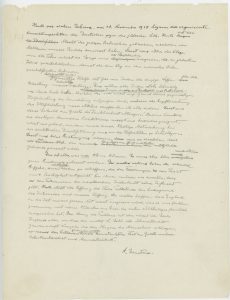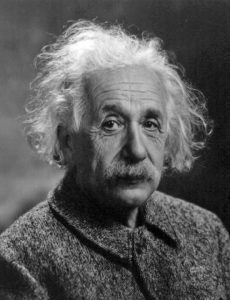Albert Einstein Handwritten Letter to be shown at The FHM
Zoe Wright, Public Relations Intern
The Florida Holocaust Museum will unveil a rare letter handwritten by Albert Einstein on July 9, 2019. The letter will be on display in the Museum’s permanent exhibition, History, Heritage and Hope, located on the first floor. The letter was donated by past board chair and longtime Museum volunteer, Irene Weiss and her brother Peter Cohn.
The letter was printed in der Aufbau, a journal printed for German-speaking Jews. The letter is a draft of the printed version, complete with his edits and signature. Der Aufbau was founded by the German-Jewish Club in 1934 in New York City. The original purpose of the journal was as a monthly newsletter, including helpful facts and information for Jewish refugees in the United States. The letter was published on November 16, 1945 to coincide with the seven-year anniversary of Kristallnacht. His letter was a plea to the Jewish community to render assistance to Holocaust Survivors while calling on Great Britain to open immigration quotas for Survivors to emigrate to Palestine.
Jewish land purchases in Palestine were heavily restricted by the British making Jewish acquisition of immigration certificates very difficult. After World War II, the British did not allow Holocaust Survivors to find sanctuary in Palestine. On June 6, 1946, a few months after Einstein’s letter, President Truman urged the British government to relieve the suffering of the Holocaust Survivors by immediately accepting 100,000 Jewish immigrants.

Thankfully, some Holocaust Survivors were able to reach Palestine. Many of them made it on old ships, smuggled in by Jewish resistance organizations. Between August 1945 and the establishment of the State of Israel in May 1948, 65 immigrant ships, carrying close to 70,000 people arrived from Europe.
Dr. med. Siegfried Kurt Glaser, the grandfather of the donors, assisted Einstein in its composition. Einstein and Glaser knew each other before the war in Germany. Glaser, like Einstein, was a refugee to the United States.
Albert Einstein’s legacy is that of an incredible physicist and Nobel Laureate, but he was also a German Jewish refugee. After visiting the U.S. in 1933, Einstein decided to stay rather than returning to Germany after the Nazi rise to power the same year. After Hitler rose to power as chancellor, Einstein renounced his German citizenship. Einstein and his wife, Elsa were advocates for Jews seeking refuge outside of Germany. They called for the foundation of the International Relief Effort, which is still in existence today.
The International Relief Effort was made up of a committee of 51 prominent American intellectuals, political leaders, clergy and artists. The foundation of the committee was at the request of its chief, Albert Einstein. Eleanor Roosevelt, John Dos Passos, John Dewey, and Reinhold Niebuhr were among the many that served and supported the foundation. Before this, there were no refugee programs or aid agencies that ensured the safety of refugees who were fleeing Europe. These volunteers were among the first of civilians to offer aid to displaced peoples and Holocaust Survivors after the end of World War II in 1945.

The FHM is very thankful for the donation from Irene Weiss and Peter Cohn. The FHM is always looking for original objects, documents, and photographs that tell the stories of those who suffered during the Holocaust. For donation inquiries, please contact Erin Blankenship at eblankenship@thefhm.org
